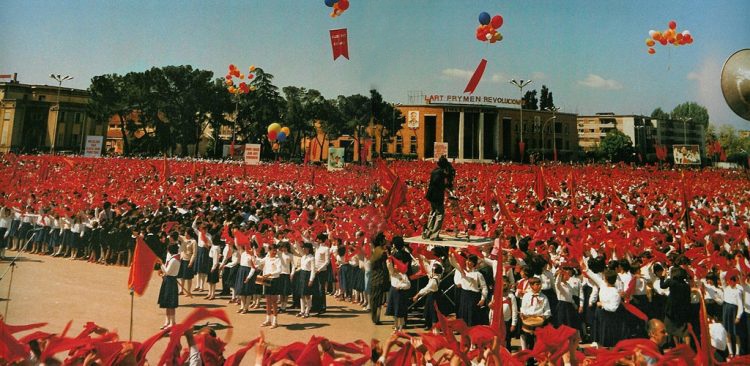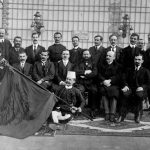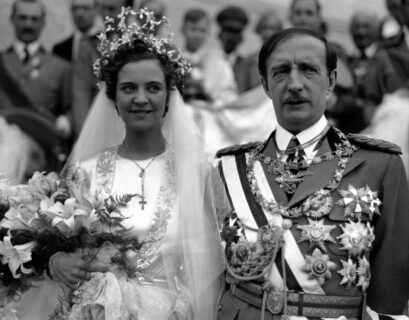L. Tzounis
One essential point must be grasped in order to understand the external economic relations of Albania: from the establishment of the Communist regime until 1978, .when Albania broke with China , foreign trade was directly dependent on the foreign policy pursued by the Albanian leadership. The Albanian regime attempted systematically to align tiny Albania exclusively with – or, to be more precise, to attach itself to – a larger communist country which could give it political, diplomatic, military and economic support and defend its interests both at home and abroad.
Public opinion and international observers were impressed chiefly by the dramatic manner in which Albania broke with its successive patrons and the ideological justifications it gave for this as well as its extreme views on national independence. It is true that each patron was replaced by another one more distant – and therefore more harmless or at least less dangerous.. Perhaps the real reason for the realignments of Albanian foreign pol icy was the determination of Albanian leaders not to allow some new political line adopted by rulers of the protecting country to endanger their position.
At all events, one of the consequences of the close and exclusive dependence of Albania on its three successive patrons, Yugoslavia (1944-1948), the Soviet Union 0948-1961) and China (1961-1978) has been that each patron has in turn accounted for an exceedingly large share of Albanian foreign trade. Each break has led to the total cessation of all economic ties , and this has had very serious implications for the economic development of the country (the interruption of development programmes, the withdrawal of technical advisers and of credit facilities). Foreign trade with the former patron was reduced to nothing overnight. Exactly the same scenario was re-enacted three times. And amongst the other unpleasant consequences of these breaks, Albania suddenly lost almost its only trading partner. One can therefore justifiably to refer to ‘political’ foreign trade, or at least foreign trade exceptionally sensitive to foreign policy.
A substantial change has taken place since 1978. Albania no Longer seems to be Looking for new patrons. This is perhaps due to the fact that the Albanian leadership considers its position strong enough and the Albanian economy sufficiently stable to stand on its own two feet. Besides, Albania has exhausted the stock of possible patrons in the Communist camp. Its foreign trade is more balanced, no longer characterized by the one- sided alignment of former times. Political considerations are not so important in its choice of trading partners.
Let us examine in some detail the two phases of Albania’s external economic relations.
- The period of exclusive economic partners (1944-1978)
- Relations with Yugoslavia (1944_1948)
At the end of the Second World War the Albanian regime, aware of its political weakness and of the immense problems facing Albania, a poor country ravaged by the war, was anxious to bring about radical economic and social change. Albania clearly needed foreign aid and it was natural that it should turn to neighbouring Yugoslavia, especially in view of the very active role played by the Yugoslavia, especially in view of the very active role played by the Yugoslav Communist Party in supporting the
fledgling Albanian Communist Party and the blessing given by the Soviet Union. Problems which had arisen between the two states during the two World Wars (border disputes, a tendency on the part of Yugoslavia to interfere in Albania’s internal affairs) were brushed aside.
Economic cooperation between the two countries was particularly close after 1944. They decided to coordinate their economic programmes, the Albanian lek was put on a par with the Yugoslav dinar, a single customs area was established and customs duties between the two countries abolished. Plans were made to set up joint companies for the exploitation of raw materials, for foreign trade and other sectors. It is estimated that economic aid from Yugoslavia to Albania during that period amounted to $33 m. The Yugoslavs claim that their financial aid constituted 57% .of the revenue of the Albanian state in 1947 and 48% in the following year. The development of Albanian foreign trade during this period clearly shows the importance of Yugoslav aid: Albanian imports which amounted to only $2.05 m in 1946 leapt to $30. 27 m in the following year while exports rose from $1. 91 m in 1946 to only $4.75 m in 1947. This trade deficit could not have been covered without Yugoslav aid.
The decline in trade following the deterioration and subsequent severing of relations with Yugoslavia are equally significant: import plummeted to $18.8 m in 1948 and to $12.89 m the following year. Exports continued to rise in 1948 ($8.33 m ) but these, too, fell in 1949 to $5.82 % m.
The events which Led to Yugoslavia s break with the Soviet camp are well documented. Albania did not follow Yugoslavia s Lead and pro-Tito elements lost the struggle for power. Enver Hoxha remained in power and Albania aligned itself exclusively with the Soviet Union, cutting off relations with Yugoslavia and reducing its trade with that country to nil. Albania geographical separation from the Soviet camp by non-aligned Yugoslavia was to prove an advantage ta the Albanian regime later in 1961 when it decided to dissociate itself from Krushchev’s Russia.
- Relations with the Soviet Union (1948-1961)
The Soviet Union and its satellites fully .occupied the place vacated by Yugoslavia in Albania s economy and trade. From 1948 to 1961 these states literally monopolized Albania s foreign trade. During this period COMECON member states accounted for an exceptionally’ high proportion of Albanian trade: for instance, 99.94% in 1950, 99. 70% in 1952 and 99. 29% in 1955. These figures speak for themselves. During the period from 1950 to 1961 the percentage of Albanian trade accounted for by the Soviet bloc fell below 90% only in 1956 (87. 71%) and in 1957 (86. 90%), very probably owing to the upheavals of the destalinization and the events in Hungary and Poland, and of course in 1960 (88. 68%) and in 1961 (75. 59%) when the break was imminent.
The Soviet Union naturally accounted for the bulk of this trade: it frequently accounted for more than 50% of Albanian trade, as in 1951 (57. 95%), 1953 (51. 96%), 1958 (54. 11%) and 1960 (53.89%), This figure fell to 36. 05% in 1961 the last year of the Soviet-Albanian friendship (these two countries cut off diplomatic relations on 3 December 1961 and Albania withdrew from the Warsaw Pact in 1968 following the Soviet invasion of Czechoslovakia. Albania
remained a member of COMECON but was inactive as it did not pay its contribution). In the following year trade was non-existent. The Eastern European countries accounted for the remaining share, Led by Czechoslovakia with its developed industrial sector. It is interesting to note that trade with these countries continued even when Albania broke off diplomatic, economic and trade relations with the Soviet Union , very probably at the instance of the latter. So the percentage of Albanian trade accounted for by COMECON countries, minus the USSR, was 38. 09% in 1962 and subsequently remained at a similar relatively high level.
During its honeymoon with the Soviet Union, Albania had substantial foreign trade deficits. This problem was overcome by significant economic aid from Russia estimated at approximately $156 m for the period between 1947 and 1961; on top of this the Soviet Union granted a further sum of approximately $100 m in the form of military and technical aid. Other Eastern European countries also furnished aid amounting to approximately $133 m.
The measures taken by the Soviet Union preceding the break with Albania and the manner in which this break was effected had serious repercussions on the Albanian economy and Albanian trade. The Albanian political leadership, however, would have no truck with destalinization and there was nothing to stop it establishing the same kind of relations with China.
- Relations with China (1961 – 1978)
Trade relations between China and Albania were initially on an exceedingly modest scale: China accounted for only 2. 27% of trade in 1955, 98% in 1960 and 18. 41% in 1961. But the break between Albania and the Soviet Union led to an impressive jump in Sino-Albanian trade to 50.03% in 1962 and 54. “13% in the following year. And trade seems to have remained at approximately that level for the whole period of the Sino-Albanian friendship.
China, too, undertook to finance the Albanian economy and its foreign trade deficits. No reliable information is available regarding the level of aid granted: the Chinese claim that they provided aid worth $5,000 m between 1957 and 1978, whereas Western sources claim that Chinese aid did not exceed $838 m between 1959 and 1975.
For the third – and Last – time, therefore, Albanian foreign policy led Albania to exclusive dependence on one trading partner. The Sino-Albanian friendship lasted longer than its predecessors, possibly because distant China was less able to impinge on the internal affairs of Albania. However, Albania feared ~hat certain changes which occurred in the Chinese political scene might prove contagious and thus brought ,to an end the friendship between the two countries with ideological purity once ‘again furnishing the pretext.
- The period of multilateral Albanian foreign trade (1978 – ?)
In 1978, however, the Albanian Leadership was more self-confident and the economy was Less in need of support. It considered that the three successive breaks with its three successive exclusive trading partners had cost the country enough already – although it should be noted that Albania partly offset the damage caused by these breaks by failing to repay its debts to its former patrons – and it was not keen to repeat the process. Foreign trade lost some of its political and ideological strings and Albania sought some kind of balance in its choice of trading partners. However, since it was deprived of economic aid , Albania was forced to make systematic and intensive efforts to restrict somehow its trade deficit.
- Relations with the Community
These changes brought about an improvement in trade with Member States of the European Community. Trade with the EEC had been non-existent in the 1950s , but improved somewhat owing to China s inability to replace the Soviet Union in supplying certain products. The situation has improved still further since the break with China.
Of course, from an ideological point of view, Albania totally rejects the European Community. This is illustrated for instance by the letter of the Central Committee of the Albanian Party of Labour and the Albanian Government to the Chinese authorities on 29 July 1978 (in which it officially announced the break with China). Albania accused China of ‘ aiming to strengthen the Commonf4arket and European Union, entities created to maintain the proletariat of Europe in capitalist slavery and to oppress and exploit other peoples
In practice, however, trade between Albania and the EEC has improved fairly clear picture of Community trade with Albania over the last few years emerges from the tables given in the annex to this report: they give overall trade figures as well as figures for each Member State, show the level and type of trade involved and indicate that the Community enjoyed a positive trade balance (between 1974 and 1984 it was negative only in 1979, 1980 and 1981 ) .
However, some distinction should be drawn between the positions of the various Member States. For historical reasons Italy has been particularly keen to cultivate relations with Albania. The two countries have signed important agreements and organized meetings at ministerial level; more significantly” a decision has been taken to set up a ferry Link between Trieste and Durres with ferries sailing every ten days (these are 5,000 t. ships and have a capacity of 30 lorries, 200 cars and 750 passengers). Italy today does more trade with Albania than any other Member State of the EEC and on a world scale is second only to Yugoslavia.
Relations between Greece and Albania are unusual. Diplomatic relations between them were restored only in May 1971 during the colonels ‘ regime in Greece; officially, however, Greece is still in a state of war with Albania. The subject of the Greeks in northern Epirus remains a source of friction. Despite this, a series of agreements have been signed, trade has considerably increased, the Greek national airline operates flights to Tirana,
road communications between the two countries have improved although traffic is maintained at a very low level (on 1 January 1985 the border post of Kakavia was reopened for transfrontiers traffic) and Albania sells electric power to Greece. An agreement has recently been signed providing for a ferry service to be set up between Corfu and Aghia Saranta.
The Federal Republic of Germany is another Member of the Community with significant trade links with Albania, despite the fact that diplomatic relations between the two countries have not been restored as Albania is still demanding war reparations.
The united Kingdom, on the other hand, does only a limited amount of trade with Albania. The restoration of diplomatic relations is prevented by a continuing dispute between the two countries dating back to the incident in the Corfu Channel. The United Kingdom demands the payment of the compensation (amounting to approximately f840,000) awarded to it by the International Court of The Hague after two British destroyers hit mines in 1946 and, until such time as it obtains satisfaction, is refusing to return to Albania 2, 450 kilos of gold belonging to the National Bank of Albania.
The European Community seems a natural trading partner for Albania. Its geographical position, its economic strength and its technological know-how ideally suit it for this role; and, of course, with no political strings attached.
- Relations with Yugoslavia
The fact that Yugoslavia is once more Albania s leading trading partner sheds an interesting Light on the new Albanian attitude to foreign trade. As has already been mentioned, trade between the two countries came to a complete standstill after the 1948 break. The Albanian Leadership s fierce ideological opposition to Marshall Tito s regime long precluded any resumption of trade between the two countries. After remaining at an extremely modest level for many years, Yugoslav-Albanian trade is very gradually beginning to recover (in 1983 it amounted to approximately $130 m).
Since 1981, however, a new crisis in Kosovo has caused considerable tension between the two countries. (Kosovo is an autonomous region in Yugoslavia with a sizable Albanian population; severe disturbances broke out there in spring 1981. This has Led to a decline in trade between Albania,and Yugoslavia and seems to have been responsible for the delay in the completion of a fifty-four-kilometre track from Titograd to Skodra , connecting the railway networks of the two countries, a long-standing Albanian demand.
In addition.. certain restrictions have been imposed on Albanian lorries passing through Yugoslav territory. However, it is clear that both sides are attempting to defuse the situation as they do not wish to allow trade to become a victim of political differences. However, the fear that Yugoslavia might obstruct their communications with the rest of the world and confine
Albanian trade to Yugoslavia is perhaps encouraging Albania to seek closer links with Western Europe.
- Relations with Turkey
Recently relations with Turkey have somewhat improved: ministers have exchanged visits, a trade agreement was signed in 1982 and renewed two years. Later and an aviation agreement was concluded in 1984 but flights have not yet been scheduled between the two countries.
- Relations with the USA and China
Another indication that political considerations no longer dominate Albanian foreign trade i s the – by Albanian standards – considerable volume of trade with the USA amounting to several millions of dollars, despite the fact that there are no diplomatic relations between the two countries and Albania is constantly voicing its opposition to and condemnation of the United States in the most strident manner.
Likewise, the ideological and political break with China does not seem to have put an end to Sino-Albanian trade. A Chinese trade delegation visited Tirana in spring 1983.
Since 1978 therefore Albania has increased the number of its trading partners and no Longer chooses them exclusively on the basis of political and ideological criteria as was previously the case. The Community has already benefited from this development and may be able to derive further advantage from it in future.










